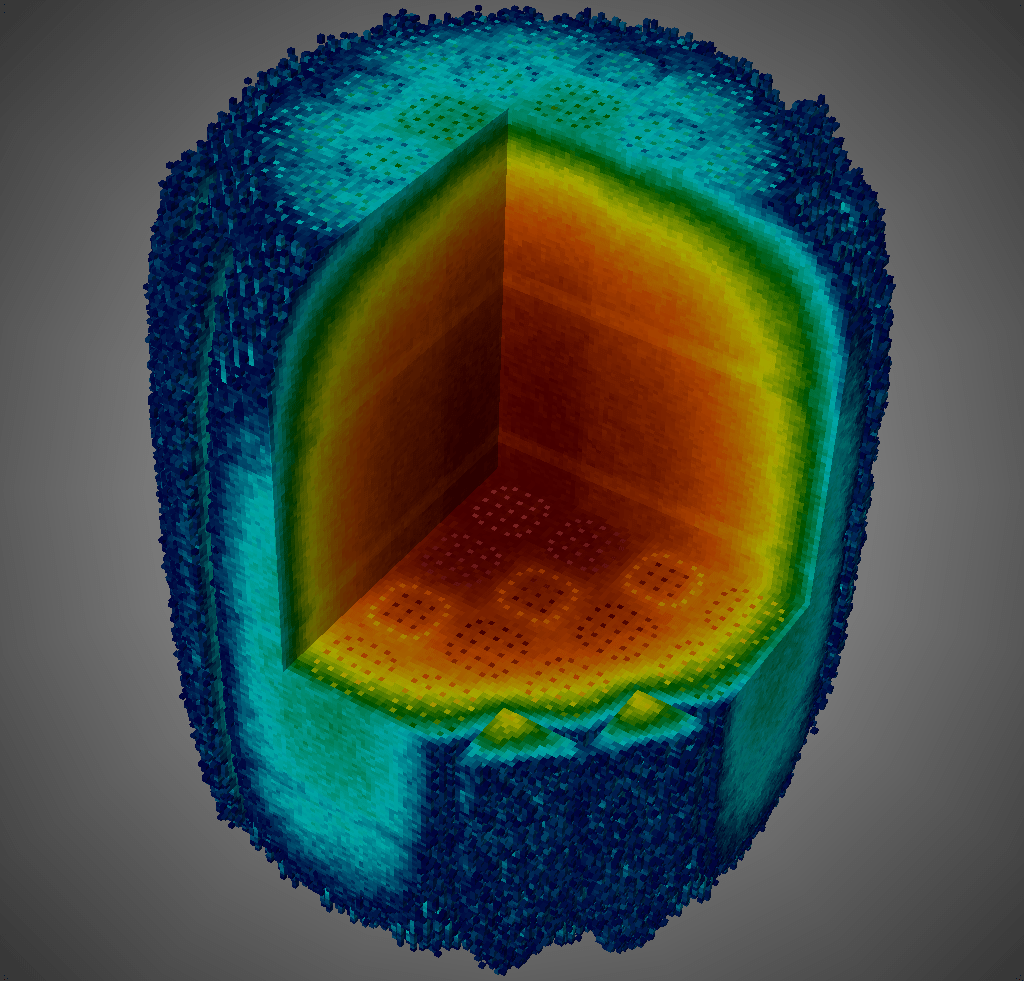Experts believe that nuclear power – along with renewable energy sources like wind and solar – can help mitigate the accumulation of climate-changing greenhouse gases. Indeed, for decades, nuclear plants have reduced dependency on fossil fuel and supplied nearly carbon-free energy.
China and Russia are the biggest producers, but in America and other countries, first-generation plants have reached the end of their operating lifetimes and are closing without replacements.
One big problem with those aging reactors: They’re located near rivers or other large bodies of water that they tap to cool reactor-generated heat. Spent fuel rods, still radioactively hot, have accumulated at these facilities over the decades. Oak Ridge National Laboratory’s Steven Hamilton and colleagues hope to address those problems through supercomputing, simulating what happens in small modular reactors that are less water-guzzling and burn nuclear fuel with improved efficiency.
Hamilton leads ExaSMR, part of the Department of Energy’s Exascale Computing Project. ExaSMR has been nominated for a 2023 Gordon Bell Prize by the Association for Computing Machinery. The project is one of six finalists for the annual award, presented at SC23, the international high-performance computing meeting Nov. 14-16 in Denver.
ExaSMR researchers are modeling energy generation in devices called small modular reactors (SMRs). A single such plant produces a fraction of the electricity of a conventional one, but companies can cluster them to increase capacity. This gives utilities leeway on where they place facilities. SMRs’ smaller parts are also easier to manufacture, Hamilton says, possibly helping increase reactor production. No SMRs are operating yet.
Nuclear reactors split uranium atoms’ nuclei and release neutrons, a process called fission. This produces heat, making steam that turns turbines and generates electricity. In traditional reactors, massive pumps force water through the reactors’ core to cool the fuel rods. SMRs lack these pumps; the water they use moves naturally as fission reactions warms it. Additional factors come into play when a reactor starts, including predicting how the heat that’s generated interacts with the coolant and how that flow will begin, Hamilton notes.
Hamilton and his colleagues are teaming with Westinghouse Electric Co. to study high-enrichment fuels the Nuclear Regulatory Commission hasn’t yet approved. Standard fuel rods contain up to 5% of uranium-235. Hamilton and Westinghouse are investigating ones that would hold 8 to 10% of the isotope that, if successful, would burn up more fuel than conventional reactors and leave less waste.
The Oak Ridge team’s simulations use the Monte Carlo neutron support algorithm to follow particles’ individual trajectories. When uranium-235 fissions, it loses neutrons, which move through the core, interacting with the fuel material and other isotopes in a chain reaction. The Monte Carlo code lets engineers monitor the fate of these neutrons and calculate the probability that they’ll interact with a given material.
‘Maximizing efficiency helps guarantee the economic viability of the systems.’
So far, Hamilton and his colleagues have performed a simulation on the Oak Ridge Leadership Computing Facility’s Frontier exascale system involving more than 3 trillion neutron histories, he says. “As you simulate more and more of these histories, you get a feel for what the average behavior of a neutron in that system is. And that average behavior very closely mirrors what happens in a physical system.
Ideally, fission would generate heat uniformly throughout the reactor. These simulations tell researchers how much is produced and where. Engineers can use this information to place structures called absorbers inside the reactor that sop up neutrons and balance the heat distribution.
“If you don’t do any of these things, the heat tends to be concentrated in the center of the reactor,” Hamilton says. “By carefully selecting where you put the fuel rods of different enrichments and where you put absorbers, it allows you to create a more efficient overall pattern.”
The same simulations also let the researchers see how the heat distribution changes as fuel evolves. When uranium-235 is consumed in what’s called isotopic depletion, the materials and subsequent heat generation also change. “The way that change happens is really important to understand how efficient a reactor will operate,” Hamilton says. “Maximizing efficiency helps guarantee the economic viability of the systems.”
Hamilton hopes the computational tools he and his team are developing for ExaSMR can be user-friendly enough for application to a range of next-generation reactor designs. For instance, X-energy, a nuclear power company based in Maryland, is developing a pebble-bed reactor – fueled by gas-cooled tennis-ball-sized pellets.
Such tools can help confidently predict how new systems would behave and reduce the number of physical experiments researchers and engineers must perform to ensure a new type of reactor is safe, Hamilton says. All this work could then help make the nuclear industry a bigger player in climate change mitigation.

